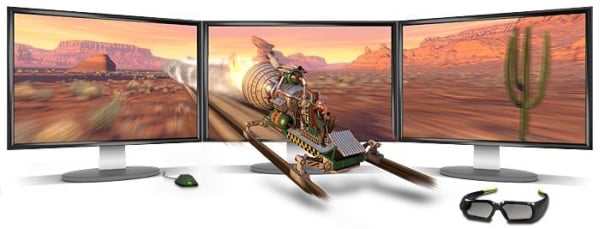NVIDIA 3D Vision Surround is Here
In January 2009, we reviewed the NVIDIA 3D Vision kit which brought the latest in 3D active-shutter technology to the PC gaming world. Since then, 3D has exploded on to the scene as motion pictures, games, and other video media all have support for the technology in a major way. Nowadays, when you go to a movie theater, chances are you'll have the option of watching new releases in either 2D or 3D. Moreover, HDTVs and Blu-ray players now offer 3D capable features that bring stereoscopic technology right into your living room. Of course, PC gaming is also on the bandwagon as hundreds of games support 3D out of the box. It's obvious we're heading toward a world where every facet of entertainment is available in 3D and its becoming more of a reality every day.

In addition, the rise of multi-monitor gaming has given users another way to immerse themselves within games. Matrox's TripleHead2Go and ATI's Eyefinity technology provide gamers with single large surface that spans multiple monitors and produces colossal resolutions. For months, we've read about NVIDIA's implementation of this concept and expected to see it launched in conjunction with the release of their Fermi graphics cards. Although the hardware necessary to set up NVIDIA Surround is widely available, the drivers needed to run it have been missing in action... until now.
Today, NVIDIA is ready to release 3D Vision Surround technology to the masses. With the release of their latest driver, users can connect three 3D Vision capable monitors to a pair of GeForce videocards to experience cutting-edge gaming that promises to provide a level of immersion never seen before on the PC. Of course, there are several differences between NVIDIA' technology when compared to other multi-monitor gaming solutions, and we'll provide you with those details on the following pages. Was it worth the wait? Read on as we test 3D Vision Surround and give you the information you need to figure out if its worth the upgrade.
|

Don't bring that weak stuff around here. Without a doubt, the system requirements for 3D Vision Surround are demanding, but gamers who want the ultimate experience are used to paying extra for cutting edge tech. Surround mode requires any three monitors with a common resolution so adding one or two displays to your existing setup is the first step. But 3D Vision Surround asks for three 3D Vision LCDs or projectors of the same exact model. Add in the requirement for two current-generation GeForce cards in SLI and you're looking at a hefty investment for gaming nirvana. On the following pages, we'll take a closer look at the hardware you'll need to set up 3D Vision Surround, and provide some performance numbers comparing 2D multi-monitor gaming using NVIDIA SLI and AMD CrossFire.






